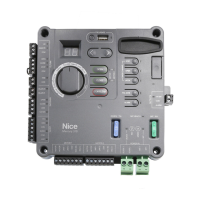MERCURY 310 Controller
User Guide
1313
MX5096 Rev. C ©2022
of recycling metal and plastic. Using a metal and plastic
recycling center promotes energy cost savings.
WIND LOAD
When the IES (type A sensor) trips, it
sends a signal to gate operator to stop
and reverse direction. This feature may
be falsely triggered in excessively windy
conditions because wind itself, acting
over surface area of gate panel, can
provide necessary force to trigger IES.
CAUTION
Do not adjust IES sensitivity/Force setting to
accommodate for inappropriately designed gate
panels. Loss of IES sensitivity increases mechanical
wear on gate hardware and gate operator. It may also
pose a safety hazard. Compensating for wind loads by
adjusting IES may set IES sensitivity to a level which,
when encountering an obstruction, ignores obstruction
and fails to reverse direction.
MAINTENANCE OF GATE SYSTEMS
To keep your automated gate system performing both safely
and reliably it is important to ensure that the components of
that system are functioning properly.
At least monthly:
z
Disconnect the gate operator and manually move the
gate through its range of travel. Note any squeaks from
rollers or hinges or areas of binding. The gate should
travel smoothly and quietly throughout its range. If it
does not, contact a gate professional to correct the
problem.
z
Reconnect the gate operator and perform the following
tests:
•
With the gate opening, block any photo eyes and/
or depress any safety edges used to protect the
open direction. The gate should stop and/or reverse.
•
With the gate closing, block any photo eyes and/or
depress any safety edges used to protect the close
direction. The gate should stop and/or reverse.
•
Using a suitable obstruction in the path of the gate
(a solid, immovable object), run the gate in the open
direction until it contacts the obstruction. The gate
should stop and reverse, or it will just stop if a Type
C sensor is engaged before the Type A sensor is
tripped.
•
Using a suitable obstruction in the path of the gate
(a solid, immovable object), run the gate in the close
direction until it contacts the obstruction. The gate
should stop and reverse, or it will just stop if a Type
C sensor is engaged before the Type A sensor is
tripped.

